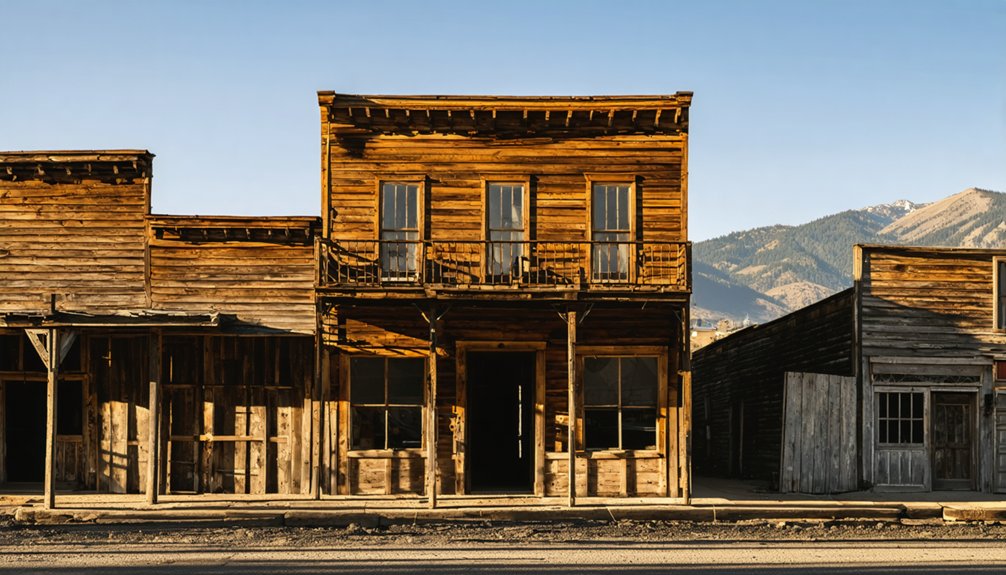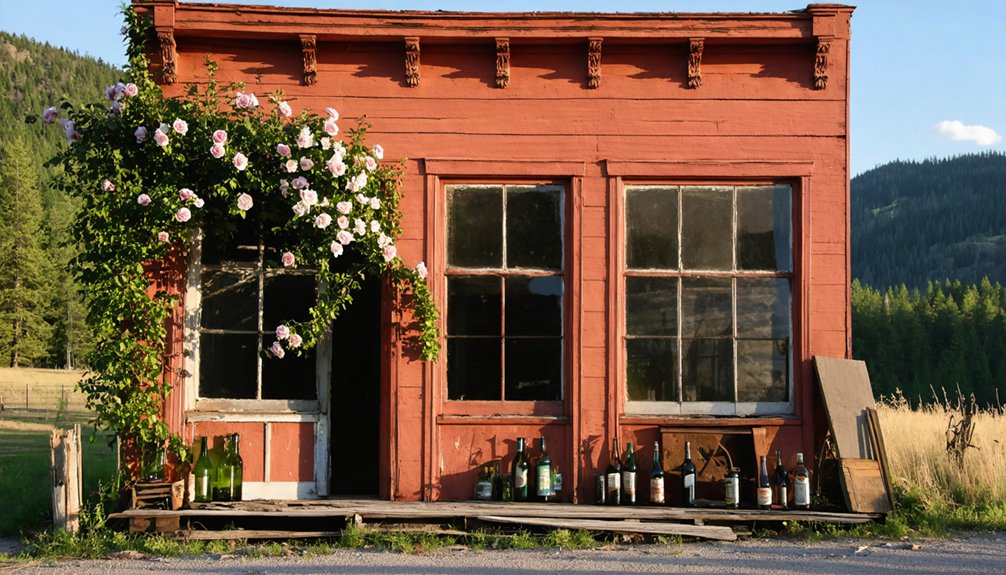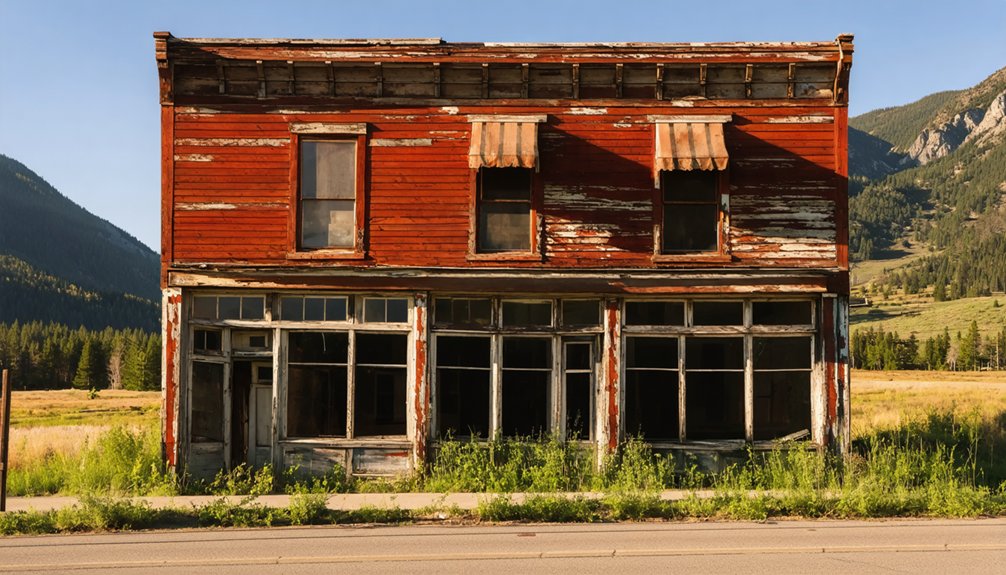You’ll find Murray, Idaho nestled in the northern panhandle, where A.J. Pritchard’s 1882 gold discovery sparked an explosive rush that drew 5,000 fortune seekers. This once-bustling frontier town boasted 44 saloons, hosted legendary figures like Wyatt Earp and Calamity Jane, and served as the Shoshone County seat. Today, you can explore its preserved historic courthouse, Masonic Hall, and Sprag Pole Museum while uncovering tales of hidden gold and rowdy prospectors that echo through its streets.
Key Takeaways
- Murray, Idaho boomed during an 1880s gold rush, reaching 5,000 residents before declining to near abandonment when gold deposits depleted in 1898.
- Notable figures like Wyatt Earp and Calamity Jane visited the once-bustling town during its peak mining years.
- The 1885 courthouse and 1886 Masonic Hall remain as preserved landmarks of Murray’s gold rush era.
- The Historic Murray First Foundation offers guided ghost town walking tours and maintains historical structures from the mining period.
- The Sprag Pole Restaurant and Museum houses mining artifacts, while interpretive signs throughout town detail Murray’s dramatic rise and fall.
The Birth of a Gold Rush Town
Three significant events in 1882-1884 marked the birth of Murray, Idaho as a prominent gold rush town.
First, Andrew J. Pritchard’s gold discovery on Prichard Creek in 1882 sparked a rush that would transform the remote wilderness. Though he tried to keep it secret, word spread quickly, drawing thousands of fortune seekers to the area by 1883.
As prospectors flooded the North Fork of the Coeur d’Alene River and staked their mining claims, the need for a central hub became clear. The area saw rapid development with twelve stores and numerous other businesses opening to serve the growing population. The town’s explosive growth was evident as forty-four bars lined its bustling main street during the peak of the rush.
On January 22, 1884, Murray was officially established on three creek claims. You’d have witnessed a remarkable transformation as the town, initially called Murrayville, quickly took shape.
Life in Murray’s Wild West Days
Building upon its rapid establishment, Murray quickly evolved from a basic mining camp into a vibrant frontier community.
You’d find the town’s pulse beating strongest at the courthouse and Masonic Hall, where social gatherings and community governance shaped daily life. These institutions helped maintain order during the population surge of thousands following the 1882-83 gold discoveries. During its peak, the town reached a population of five thousand residents looking to strike it rich.
If you’d visited Murray in its heyday, you’d have witnessed a bustling town where banking, newspaper operations, and hospitality services thrived alongside mining activities. The town’s legendary main street featured forty-four bars that catered to miners and travelers alike.
The architecture reflected the harsh realities of north Idaho winters, with frame construction and pitched gable roofs designed to handle heavy snow loads.
While miners sought their fortunes, families established permanent homes, creating a structured social fabric that would define Murray’s character through the 1880s and 1890s.
Mining Legacy and Economic Impact
Murray’s 1880s gold rush transformed the remote Idaho wilderness into a booming economic hub, where you’d find thousands of miners working claims along Prichard Creek with their sluice boxes, rockers, and other placer mining equipment.
You can still see evidence of this prosperity in the town’s infrastructure, including the preserved courthouse and Masonic Hall that were built during the peak mining years.
The mining operations brought significant wealth to the region, helping Murray secure its position as the Shoshone County seat and establishing it as one of Idaho’s most important gold mining centers during the late 19th century.
By 1898, Murray had experienced a dramatic decline as precious ore deposits became depleted, leading to its near abandonment.
The initial gold discovery by AJ Pritchard in 1882 sparked the rapid development and population surge that would define Murray’s early years.
Gold Rush Economic Boom
The discovery of gold by Andrew J. Prichard in 1883 sparked an unprecedented gold rush that transformed Murray, Idaho into a thriving boomtown.
You’ll find that within just two years, the area’s population exploded to nearly 10,000 people, creating a remarkable economic boom that reshaped the landscape.
As you explore Murray’s history, you’ll see how the rush brought immense wealth, with gold production reaching $1 million during its peak.
The economic surge led to rapid development, with businesses springing up to serve the influx of miners.
You’ll discover that saloons, supply stores, and even a red-light district emerged practically overnight.
Notable figures like Wyatt Earp and Calamity Jane established themselves in the bustling mining town during its heyday.
The town’s prosperity earned it the status of Shoshone county seat in 1885, complete with a courthouse that still stands as a symbol of Murray’s golden age.
The booming economy supported an impressive forty-four saloons throughout the town during its peak years.
Mining Equipment and Infrastructure
When gold fever struck Murray in 1883, mining operations relied heavily on primitive yet effective equipment to extract precious metals from the earth. Historic equipment included stamp mills powered by water or steam, wooden sluices, and rocker boxes for placer mining along creek beds.
You’ll find that blacksmith shops and supply stores supported local mining by repairing and fabricating essential mining tools. The area’s mining legacy echoes the broader Silver Valley district which has produced over 1.2 billion ounces of silver throughout its history.
The town’s infrastructure grew rapidly to meet miners’ needs, with water ditches and mills strategically placed near creek claims. Transportation evolved from pack mules and sleds to wagon roads, improving ore movement throughout the region. The addition of the Northern Pacific railroad in the 1910s briefly enhanced the town’s mining capabilities.
Today, you can still spot remnants of 19th-century mining equipment around Murray, though modern operations like the Golden Chest mine now employ advanced technology for mineral extraction.
Colorful Characters and Local Legends
Drawn by the promise of quick gold fortunes, a cast of colorful characters helped shape Murray’s wild frontier reputation during its boom years.
You’ll find saloon stories about notorious figures like Wyatt Herp, who faced charges for claim jumping, and the legendary Calamity Jane who passed through during the town’s peak.
Perhaps most infamous was Maggie “Molly B Damned” Burton, whose saloon offered unconventional “bathing assistance” services for gold dust tips.
The town’s 44 bars along main street served as the backdrop for these legendary figures, while the courthouse doubled as a drinking establishment where you could watch trials with a drink in hand.
Even today, tales of hidden gold and rowdy prospectors echo through Murray’s near-empty streets.
Historic Buildings and Landmarks

Standing as a tribute to Idaho’s gold rush era, Murray’s historic buildings offer glimpses into its brief but prosperous heyday as a mining boomtown.
You’ll find the 1884 Masonic Hall, Idaho’s oldest continuously operating lodge, showcasing original furnishings and artifacts from the 1880s. The Murray House, once a bank and newspaper office, now welcomes visitors as a bed and breakfast while maintaining its architectural significance.
The Sprag Pole Inn and Museum exemplifies historic preservation, combining hospitality with local heritage in its original 1884 structure.
Throughout town, you’ll discover abandoned mining buildings, weathered cabins, and commercial storefronts that tell the story of Murray’s evolution from a rugged mining camp to the Shoshone County seat during the late 19th century.
From Bustling Hub to Ghost Town
After A.B. Prichard’s gold discovery in 1883, you’d have witnessed Murray’s explosive transformation from wilderness to a bustling hub of 2,000 residents.
From untamed wilderness to a booming frontier town, Murray’s 2,000 souls emerged swiftly after Prichard struck gold in 1883.
The community dynamics thrived with 44 bars, while the courthouse handled major mining disputes, including the famous Bunker Hill Jackass case.
The economic fluctuations proved harsh and swift. By 1898, you would’ve seen a drastically different Murray as declining ore deposits triggered a mass exodus.
The once-vibrant streets emptied, businesses shuttered, and the town lost its county seat status.
Today, you’ll find fewer than sixty residents maintaining Murray’s legacy through two remaining businesses: the Sprag Pole Restaurant and Museum.
While most mining towns from this era have vanished entirely, Murray’s original buildings still stand as a monument to its golden age.
Preserving Murray’s Rich Heritage

Modern-day Murray carries forward its rich heritage through dedicated preservation initiatives. The Historic Murray First Foundation leads this charge through biweekly meetings, walking tours, and educational lectures that showcase the town’s architectural treasures.
You’ll find historic preservation efforts focused on iconic structures like the 1885 Murray Courthouse, one of Idaho’s last territorial-period courthouses, and the 1886 Masonic Hall.
Through community engagement, locals celebrate their history with events like “Molly B. Damn Days” while fighting to protect endangered buildings from demolition and decay.
Though funding remains limited and harsh weather threatens these historic structures, preservation advocates continue pushing forward. They’ve successfully made historic preservation a key political issue, recognizing its essential role in maintaining property values and Murray’s authentic character.
Modern Day Adventures and Tourism
You’ll discover Murray’s fascinating past through guided ghost town walking tours that wind through historic buildings and mining remnants, with knowledgeable locals sharing tales of the town’s golden era.
The town’s seasonal events calendar features arts and crafts festivals, historical reenactments, and community gatherings that bring the former mining hub to life throughout the year.
The surrounding mountains offer year-round recreation, including hiking the Pulaski Tunnel Trail, wildlife viewing opportunities, and scenic drives along Thompson Pass.
Ghost Town Walking Tours
Exploring Murray’s ghost town on foot offers visitors an intimate glimpse into Idaho’s gold rush era through its well-preserved 19th-century structures.
You’ll discover ghost town mysteries around every corner as you wander past the original 1884 buildings, where historical preservation efforts have maintained the authentic character of this once-bustling mining town.
Your self-guided walking tour includes these key attractions:
- The historic courthouse and Masonic Hall, showcasing the town’s brief reign as Shoshone County seat
- The Sprag Pole Restaurant and Museum, housed in an original 1884 building with mining artifacts
- The Bedroom Goldmine Bar, offering a genuine taste of frontier life
Don’t forget to check the interpretive signs along your route, which detail Murray’s dramatic rise and fall during the gold rush period.
Seasonal Events Calendar
Throughout the year, Murray comes alive with heritage-focused events that connect visitors to its gold rush past while offering modern entertainment and cultural experiences.
You’ll find seasonal celebrations like the colorful Molly B. Damn Days and Fourth of July gatherings that draw locals and visitors alike. During summer months, the Sprag Pole Museum opens its doors, while craft fairs and farmers markets showcase local artisans and fresh produce.
Community gatherings peak during the Silver Valley Cultural Weekend, featuring mining heritage displays and Indigenous history presentations.
Fall brings harvest festivals with historical demonstrations, while winter holiday events and bazaars offer unique handcrafted gifts.
Don’t miss the special courthouse tours and rotating mining exhibits that highlight Murray’s role as a former territorial-era county seat.
Mountain Recreation Activities
Modern-day Murray offers five distinct categories of outdoor recreation that transform this historic ghost town into an adventurer’s gateway.
You’ll discover world-class mountain biking on the Route of the Hiawatha, featuring 15 miles of rail-trails with spectacular tunnels and trestles. For fishing adventures, head to Tepee Creek’s blue-ribbon waters or explore the renowned Salmon River headwaters.
Experience these signature adventures near Murray:
- Trek the historic Pulaski Tunnel Trail or wander among ancient cedars at Settlers Grove
- Cycle the 72-mile paved Trail of the Coeur d’Alenes
- Navigate hundreds of OHV trails throughout Silver Valley and Sawtooth National Forest
The area’s extensive trail network accommodates hikers, cyclists, and off-road enthusiasts, while McCroskey State Park‘s diverse terrain offers additional opportunities for exploration.
Frequently Asked Questions
Are There Any Active Gold Claims Still Available Near Murray Today?
Like striking gold in a stream, you’ll find plenty of active claims near Murray today. There are 3,683 active claims you can pursue, following proper mining regulations and gold prospecting protocols.
What Happened to the Original Courthouse Records After Murray Lost County Status?
You’ll find most original records were transferred to Wallace’s courthouse after 1898, while others dispersed to regional archives, state collections, and historical societies. Some courthouse history documents may have been lost during change.
Can Visitors Pan for Gold in Murray’s Creeks and Streams?
Like a treasure hunter’s dream, you can pan for gold in Murray’s creeks and streams, but you’ll need to respect creek regulations and obtain necessary permits for recreational mining activity.
How Safe Are the Abandoned Mine Shafts Around Murray?
You shouldn’t enter these mine shafts – they’re extremely dangerous. Abandoned site hazards include unstable support beams, toxic gases, hidden vertical drops, and sudden cave-ins that can trap or kill you.
Where Did Most of Murray’s Residents Relocate After the Mining Decline?
You’ll find that most of Murray’s residents followed the mining migration to nearby Wallace, which became the new county seat, while others scattered to emerging boomtowns of historical significance throughout Idaho.
References
- https://www.youtube.com/watch?v=LQalvraFVpg
- https://www.grit.com/community/history/murray-idaho-in-the-historic-silver-valley-zb0z1707/
- https://www.ghosttowns.com/states/id/murray.html
- https://www.hmdb.org/m.asp?m=122815
- https://www.onlyinyourstate.com/trip-ideas/idaho/historic-small-town-id
- https://westernmininghistory.com/towns/idaho/murray/
- http://sfcompanion.blogspot.com/2020/03/gold-rush-fuels-murray-building-boom-otd.html
- https://history.idaho.gov/wp-content/uploads/2018/09/Murray_Courthouse_78001098.pdf
- https://en.wikipedia.org/wiki/Murray
- https://www.mininghistoryassociation.org/MurrayGold.htm



